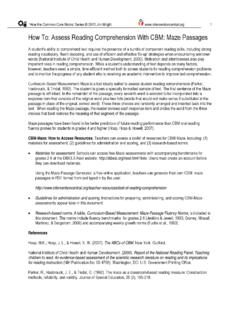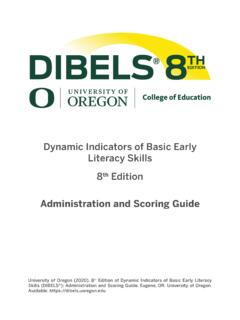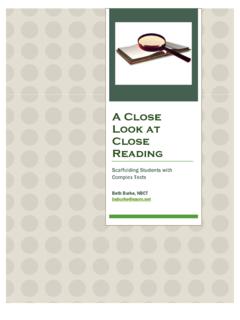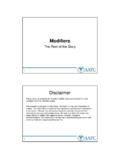Transcription of Writing SMART IEP Reading Goals - Decoding Dyslexia Oregon
1 Writing SMART IEP Reading Goals Carrie Thomas Beck, Dyslexia Specialist Office of Enhancing Student Opportunities Today's Objectives Set the stage: discuss Writing IEPs in the Endrew era Learn the steps in an if-then diagnostic assessment flowchart to determine a student's present level of performance Walk through a student case study Set appropriate IEP Goals based on a student's present level of performance Address common questions from the field Share resources De Minimis Benefit Not Enough Endrew F. v. Douglas County School District R1, 798 1329. The Supreme Court rejected some lower courts'. determinations that merely more than de minimis benefit is sufficient to provide FAPE. Rather, Individualized Education Programs (IEPs). must provide students with disabilities the opportunity to make appropriate progress. 4. The Purpose of the IEP. The IEP must aim to enable the child to make progress.
2 After all, the essential function of an IEP is to set out a plan for pursuing academic and functional advancement . (Endrew F., 2017, p. 11). To meet its substantive obligation under the IDEA, a school must offer an IEP reasonably calculated to enable a child to make progress appropriate in light of the child's circumstances. (Endrew, 2017, p. 16). 5. National Center on Intensive Intervention Appropriately Ambitious A child's IEP need not aim for grade-level advancement if that is not a reasonable prospect. But that child's educational program must be appropriately ambitious in light of his circumstances, just as advancement from grade to grade is appropriately ambitious for most children in the regular classroom. The Goals may differ, but every child should have the chance to meet challenging objectives . What Does This Mean for IEP Teams? Avoid procedural violations in the development of the IEP.
3 That could, in and of themselves, constitute a denial of FAPE. Ensure meaningful parent involvement in IEP meetings. Base the present levels of academic achievement and functional performance on academic and functional assessments and other relevant and meaningful data. Ensure that annual academic and functional IEP Goals are challenging, appropriately ambitious, and measurable. National Center on Intensive Intervention 7. What Does This Mean for IEP Teams? Develop and implement special education services, related services, and program modifications that are reasonably calculated to enable a student to make progress appropriate in light of that student's needs Continuously monitor and measure a student's progress using real data National Center on Intensive Intervention 8. Goal Writing : A Non-Example What if you had a student (Ray) who just finished second grade and: Scored in the 14th %ile on passage comprehension and low average on Reading recall Read 18 cwpm on DIBELS end-of-year 2nd grade ORF passage (goal is 72 cwpm).
4 Read with 67% accuracy (goal is 96%). Scored at the 1st grade level on high frequency words Scored at the K level in word recognition, phonics and spelling 10. Goal Writing : A Non-Example Is this an appropriate goal for Ray? When given a 3rd grade passage, Ray will read 60 words per minute with 91% accuracy and be able to answer a variety of comprehension questions with 70% accuracy in 3 out of 4 trials. 11. Goal Writing Need to assess underlying foundational skills to determine appropriate instructional Goals in the area of Reading on the IEP. 12. Goal Writing What would be more appropriate Goals for Ray? First, we will need to collect more specific diagnostic information .. 13. Types of Assessment Source: CORE Assessing Reading : Multiple Measures 2nd Edition 14. Diagnostic Assessment Plan for Students in Grades 2-12. Adapted from CORE Assessing Reading Multiple Measures STEP 1: Assess Reading Comprehension DIBELS 8th Edition: Maze CORE Reading Maze Comprehension Test AimswebPlus Reading Comprehension EasyCBM Reading Comprehension th DIBELS 8 Edition: Maze Decision Point Step 2: Assess Oral Reading Fluency DIBELS Oral Reading Fluency easyCBM Passage Reading Fluency Aimsweb Plus Oral Reading Fluency FastBridge CBMreading MASI-R Oral Reading Fluency Measures th DIBELS 8 Edition: ORF.
5 Decision Point Reading comprehension requires the activation and coordination of several skills and processes. A compromise in one or more of these skills and processes can result in difficulties in comprehending text. Kilpatrick, 2015, page 136. 22. Reading Comprehension Word Reading (we've ruled this out!). Vocabulary Syntax Background Knowledge Inferencing Attention Metacognition Working Memory Visual-Spatial-Perceptual Skills Knowledge of Genre and Text Structures Kilpatrick, 2015. If Fluency Low, Assess Decoding AND. Phoneme Awareness Common Misunderstandings About the Role of Phoneme Skills and Phonics Skills in Reading Many children do not need phonics Phonemic awareness only relates to early learning of CVC words Phonemic awareness is not involved in sight-word acquisition Phonemic awareness is not thought to be worth training after first grade If a student doesn't develop phonemic awareness by second grade, they never will Kilpatrick, 2019.
6 Reading Fluency Poor fluency signals a problem, but what precisely is the problem? There is no clear evidence in the research literature to suggest that fluency represents its own problem unrelated to other aspects of Reading . Kilpatrick, 2015. Route to Reading Fluency Letter-Sound Knowledge + Phonological Blending Phonic Decoding Phonic Decoding + Advanced Phonemic Awareness Sight Vocabulary Instant and Accurate Word Reading Kilpatrick, 2015. Two Levels of Word Reading Deficits What distinguishes skilled word readers from poor word readers? 1. The ability to identify unfamiliar words by sounding them out. 2. The ability to remember the words they read. Step 3: Assess Phonic Decoding AND. Phoneme Awareness Phonic Decoding : HM Phonics/ Decoding Screening Test CORE Phonics Survey CORE Spanish Phonics Survey Really Great Reading Diagnostic Decoding Surveys Letter Sound Fluency Word Reading Fluency Nonsense Word Reading Fluency Phoneme Awareness: DIBELS Phonemic Segmentation Fluency CORE Phoneme Segmentation Test CORE Phoneme Deletion Test CORE Spanish Phoneme Deletion Test Phonological Awareness Screening Test (PAST).
7 Phonic Decoding Houghton Mifflin Phonics/ Decoding Screening Test Really Great Reading Really Great Reading Phoneme Awareness Phonemic Segmentation Fluency CORE Phoneme Segmentation Test CORE Phoneme Deletion Test Phonological Awareness Screening Test (PAST). Phonological Awareness Screening Test (PAST). Syllable Level D and E PreK to K. Onset-Rime Level F and G K to mid Grade 1. Basic Phoneme Level H and I Early to Late Grade 1. Advanced Phoneme Level J, K and L Early to Late Grade 2. Advanced Phoneme Level M Early Grade 3 and Older Kilpatrick, 2016. Decision Point Remember: Both advanced phonemic awareness and phonic Decoding are needed to build a large sight word vocabulary and facilitate fluent Reading . Reading Assessment Special considerations: Include a timed element to PA tasks Include nonsense word tasks in addition to regular word Reading Timed nonsense words tasks a better assessment of a student's proficiency in phonic Decoding than untimed tasks Students may sometimes mimic fluent Reading Kilpatrick, 2015.
8 44. Student Case Study 8 years old female 3rd Grader middle of the school year Step 1: Reading Comprehension (Maze). Results: DIBELS Next 3rd grade Maze Adjusted score of 0. GOAL = 11+. Well below benchmark Step 2: Oral Reading Fluency Results: DIBELS Next 3rd Grade ORF. Passage 1: 15 cwpm with 63% accuracy Passage 2: 13 cwpm with 65% accuracy GOAL = 86 cwpm with 96% accuracy Well below benchmark Step 3: Phonic Decoding and Phoneme Awareness Results: DIBELS Next Nonsense Word Reading Fluency Score of 30 CLS and 1 WWR. GOAL = 54+ CLS and 13+ WWR at the beginning of grade 2. Well below benchmark for the beginning of grade 2. Student tried to use a sound out strategy for each word. She often missed the vowel sound in the CVC. nonsense words. She also had difficulty with words with b's and d's. Step 3: Phonic Decoding and Phoneme Awareness (cont.). Results: Houghton Mifflin Phonics/ Decoding Screening Test (See next three slides.)
9 Step 3: Phonic Decoding and Phoneme Awareness (cont.). Results: DIBELS Next Phonemic Segmentation Fluency Score of 43 sounds per minute GOAL = 40+ at the beginning of first grade at benchmark for beginning of first grade Student could fluently segment words such as mind, give, moon, and mouse, but had a difficult time segmenting words with parts such as ds (birds), ong (song), all (hall), nce (since). Step 3: Phonic Decoding and Phoneme Awareness (cont.). Results: Phonological Awareness Screening Test (PAST). 15/52 correct 12/52 automatic Mixed results. Student scored at the kindergarten level based on her performance across tasks, but was able to delete and substitute phonemes at the basic phoneme level when the phoneme was at the beginning of a word ( , Say grew. Now say grew, but instead of /g/ say /t/. ) which is a first grade skill. Present Level of Performance Describes the level of development Skills/activities not considered or achievement and how the child academic or related to the applies his or her learning in one child's academic achievement or more of the following areas: oral Considered routine everyday expression, listening comprehension, basic Reading activities skills, Reading fluency, Reading Examples: communication, comprehension, written social skills, behavior, expression, math calculation, and organization, self-care, fine math reasoning.
10 And gross motor May include strategies applied in learning and prefered learning styles. Academic Performance Functional Performance Using Progress Monitoring Data to Write Present Levels of Performance Describe concrete, measurable skills that have relevance to overall competence in a domain ( , Reading , mathematics). Use valid and reliable assessment tools Focus on outcomes What outcomes are desired? What do present levels say about a student's current progress toward meeting those outcomes? Compare to peers or proficiency standards National Center on Intensive Intervention 58. Present Level of Performance - Decoding Case study student is currently Reading 30 CLS. and 1 WWR per minute as measured by DIBELS. Next Nonsense Word Fluency (NWF) probes. The benchmark goal for the beginning of second grade is 54+ CLS and 13+ WWR per minute. Setting Goals Based on Logical Practices Team members must know.









